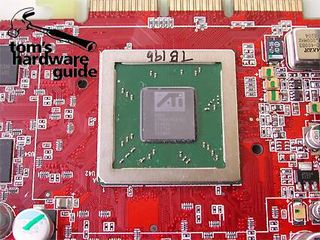ATi Radeon 9700 PRO - Pretender To The Throne
Introduction, Continued

The heart of the Radeon 9700 PRO, the "R300" in a Flip-Chip design.
Where ATi's 8500 was able to achieve technological parity with NVIDIA's flagship, the 9700 goes one step further, becoming the first card to fully support and implement all features specified in Microsoft's DirectX 9 gaming API. For now, this is a victory on paper only, since the upgrade to DirectX 9 is unlikely to happen before fall of this year, probably not until the fourth quarter. As with almost every new DirectX generation, it's hard to tell when games using these new features will even become available, although it's safe to say that it may be a while.
Nonetheless, technological evolution is essential in this industry. Several factors work hand-in-hand here. The potential buyer needs to be convinced of the validity of the technological platform before buying a given product. The more people who buy the product, the greater the installation base, which in turn helps convince software companies to include these new features in their own product. And the more software titles that implement these features, the more interested buyers are in getting a product that also offers these features. Thus, without the technological innovation from NVIDIA, ATi and others, the state-of-the art would be stuck at the same level it was at years ago. To sum it up, although new features may not be implemented in games immediately, there is definitely a long-term payoff, in the form of feature evolution, so to speak.
Luckily, this evolution is beginning to gain momentum and speed, driven in part by Microsoft's Xbox gaming console, which uses DirectX 8 as its 3D API. Since this makes the two platforms closely related, the PC stands to gain a lot. Consider - every game developed for the Xbox and then ported to the PC (or vice versa) must be at least DirectX 8 compliant!
In addition to offering new features and supporting new technologies, it is of utmost importance that a modern graphics card also be able to handle current standards correctly. Matrox's new Parhelia is a good case in point. Being a "half DirectX 9 compliant part," the card may lure many feature-conscious buyers. In reality, these features can only be seen in action in Matrox's own demos (although admittedly to stunning effect). When used with existing software, the card disappoints and is unable to fulfill the high expectations gaming enthusiasts will have of a 3D card of this price segment. It offers nowhere near the performance of a GeForce4 Ti4600, and often even comes up short against the "old" Radeon 8500, a card that costs only a fraction as much as the Parhelia.

Manufacturers who produce graphics cards with ATi chips.
It should be noted that original ATi cards (i.e., built by ATi) will only be available in North America. In Europe, ATi will leave the distribution and sales to its established partners like Hercules, while Creative will be in charge in Asia. On top of that, many other companies like Gigabyte or PowerColor will also be introducing their own take on the 9700 theme. ATi is obviously taking its cue from NVIDIA and transforming itself from a card manufacturer into a chip-maker and seller.
Stay on the Cutting Edge
Join the experts who read Tom's Hardware for the inside track on enthusiast PC tech news — and have for over 25 years. We'll send breaking news and in-depth reviews of CPUs, GPUs, AI, maker hardware and more straight to your inbox.
In the article accompanying the product launch , we already extensively covered the new technology incorporated into ATi's new flagship. Now, the first Radeon 9700 boards are finding their way into the retail channel and have to prove to gamers everywhere that this card is more than a white-paper wonder.
Most Popular


